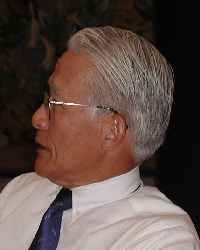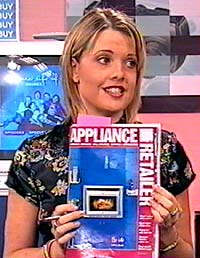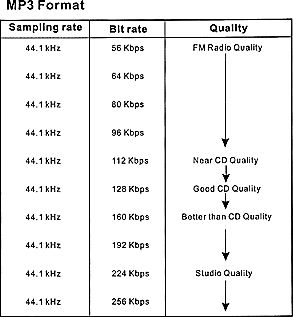Home Entertainment Blog Archive
Brought to you by your friendly, opinionated, Home Entertainment and Technology writer, Stephen DawsonHere I report, discuss, whinge or argue on matters related to high fidelity, home entertainment equipment and the discs and signals that feed them. Since this Blog is hand-coded (I like TextPad), there are no comments facilities. But feel free to email me at scdawson [at] hifi-writer.com. I will try to respond, either personally or by posting here emails I consider of interest. I shall assume that emails sent to me here can be freely posted by me unless you state otherwise.
This archive is for an uncertain period commencing Thursday, 25 September 2003
 Right now I'm sitting on the Bullet Train shooting from Osaka to Tokyo. This morning was spent doing Panasonic stuff. This afternoon was spent doing Panasonic stuff. Oh, and so will tomorrow morning. But tomorrow arvo we get released for a few hours to wander around
CEATEC (Combined Exhibition of Advanced Technologies).
Right now I'm sitting on the Bullet Train shooting from Osaka to Tokyo. This morning was spent doing Panasonic stuff. This afternoon was spent doing Panasonic stuff. Oh, and so will tomorrow morning. But tomorrow arvo we get released for a few hours to wander around
CEATEC (Combined Exhibition of Advanced Technologies).
The first event this morning was at the 'Konosuke Matsushita Memorial Hall', which traces the life history (inextricably linked with his product line) of the aforementioned gentleman. Very inspirational. Think the technical and business acumen of a Bill Gates and transplant it to Japan, 1918, when the 24 year old Matsushita began his own business fabricating extension plugs and double adaptors for the then source of electricity in most houses: the electric light socket. By dint of efficient production methods and low costs (he halved the width of the stairs in his small two story house to make more room, rather than move to more expensive premises), he was able to undercut the competition by 30%.
Next thing you know it's 2003 and the company is doing sales of more than $US61.5 billion.
 This was followed by the company's museum of Science and Technology in the middle of its huge multi-acre corporate complex in Osaka. Lots of gadgets, of interest: a fuel cell electrical generator intended for release next year. Don't think many will be sold. Target price around $AUS7,000, power output around 1.3kW. Can't even run a heater with that.
This was followed by the company's museum of Science and Technology in the middle of its huge multi-acre corporate complex in Osaka. Lots of gadgets, of interest: a fuel cell electrical generator intended for release next year. Don't think many will be sold. Target price around $AUS7,000, power output around 1.3kW. Can't even run a heater with that.
Panasonic's right behind SD (Secure Digital flash RAM cards). Apparently 1GB cards are coming out next year, and they expect them to be up to 16GB by 2007.
After lunch, we got to ask a few questions of Mr Yuiko Shohtoku, the Executive Vice President of Matsushita Electrical Company with responsibility for all aspects of the business' operations outside Japan.
The company is going to be aggressively fighting back against the inroads made in recent years by Korean companies LG and Samsung. He seemed unimpressed about what he considered to be their poaching of former Japanese executives and other unseemly activities.
The company is in the process of killing the 'National' brandname wherever it still exists (appliances in Japan and Asia mostly) and moving those product lines to the 'Panasonic' brand name, with a smattering of new premium products to make the point. 'Technics' shall remain as an 'audiophile' brand (although I haven't seen any Technics products in Australia that I would regard as even approaching audiophile quality).
 I asked whether the company had plans to introduce support into its DVD recorders for DVD-RW or DVD+RW, and into its players for SACD. On both he pulled down the shutters. DVD-RAM is technically better than the re-writable alternatives, has a huge share of the Japanese market (2/3rds) and close to 30% even in Europe (the home of DVD+RW). No way.
I asked whether the company had plans to introduce support into its DVD recorders for DVD-RW or DVD+RW, and into its players for SACD. On both he pulled down the shutters. DVD-RAM is technically better than the re-writable alternatives, has a huge share of the Japanese market (2/3rds) and close to 30% even in Europe (the home of DVD+RW). No way.
SACD: he says DVD-Audio is better (I agree, and agreed with him aloud when he asked my view). Futher, he says, DVD-A started after SACD but now has as many titles. I pointed out that consumers want a single player to handle all their discs, and that several of Panasonic's competitors offered such players. But he wasn't interested. Could it be that Panasonic, seeing the end of CD licensing fees coming, just doesn't want to have to pay any more licensing fees to Sony?
UPDATE (Saturday, 11 October 2003, 5:05 pm): On Thursday Panasonic advised that it will, in fact, be retaining the 'National' brand name for its appliances (ie. washing machines, vacuum cleaners, toasters etc) in Japan, while abolishing it everywhere else.
Well, here in Osaka, Japan, the Royal Pines Hotel has free high speed Internet if you have a network connection. At least, it's reasonably high speed if it works at all, as it did last night and does now, but as it didn't this morning.
This morning was occupied by a visit to Panasonic's consumer equipment recycling plant. In April 2001 the 'Law for Recycling Specified Home Appliances' was passed, which requires consumers to pay for the recycling of defunct TVs, refrigerators, washing machines and airconditioners. Under the law, the recyclers have to rip apart for reuse 50% of the first three (by weight,per received unit) and 60% of the latter. So Panasonic has established this five billion yen plant to do just this, with a capacity for recycling one million items per year (projected actual throughput for 2003 is 680,000 items).
In addition to the four de-production lines in the plant, there's a research lab which analyses production methods for new products to improve their future recyclability, thus the 13 different kinds of plastics used in a 1983 Panasonic TV have been reduced to two different kinds in the 2003 model.
Panasonic hasn't run a profit on this yet, thanks to the need to amortise the enormous capital cost. Their financial receipts consist of the sale of recycled materials and the cost to consumers: TVs at 2,700 yen, airconditioners at 3,500, washing machines 2,400 and refrigerators 4,500.
Afternoon, we were set loose for a couple of hours in the Yodobashi Ukemba store in downtown Osaka. This has floor after floor of gadgetary, from computers and digital cameras through to high end stereo equipment, plus pro-audio gear. The range was mind-numbing.
The odd thing was that almost everything cost just about the same as, or perhaps as much as ten percent less than, it does in Australia. An exception was a pair of B&W 801 Nautilus speakers, slightly shop soiled, which sell for 800,000 yen (~$AUS12,000) compared to the the $AUS25,000 at home.
These speakers were just packed in a row with a whole bunch of lesser speakers, close to a wall, no room to breath. There were no proper listening facilities in sight. Auditioning? Impossible. Sure, they could get them to play, but everything about the setup was wrong.
There were DVD Audio discs and SACDs on the shelf. Very restricted range of both. I fear these formats are doomed.
By the way, if you're shopping in Japan, don't get caught out. The price you pay is displayed ticket price plus 5% tax.
Or, rather, in the air. I'll be off to Japan for a few days from tomorrow, thanks to Panasonic, where I'll have an opportunity to go to the CEATEC show (Combined Exhibition of Advanced Technologies) in Tokyo. Back Friday.
I shall also be off the air. Telstra tells me that Japan uses a unique mobile phone system that is kind of a CDMA system with SIM cards. I'm not buying a phone while I'm there.
Still, if using the hotels' comms systems isn't too expensive, I ought to be able to receive email and I hope to update this Blog over there.
Thomas writes:
I am writing you because of an article you wrote and I feel you have the knowledge that I am seeking.This isn't my area of expertise, but I'll have a go at it anyway. :-)I am wonder if there is a was to have lossless or near lossless conversion from a PAL professional camcorder to a final output to NTSC format....I have final cut pro 3 and premiere 6.0 ...a dual 800 G4 and rtmac card.....
would this be possible...the camera is a Pal...aj-d200 Panasonic
I want to go pro dv and can get this camera inexpensively....I was just wondering if I should wait to go NTSC
Look, if your final product is intended to be NTSC, I would strongly suggest you acquire an NTSC video camera. High quality PAL to NTSC conversion is easier than the inverse, but I suspect that really high quality gear will cost many thousands of dollars. It's not an area I cover so you'd have to research that yourself.
Remember the differences between PAL and NTSC:
- Colour encoding: PAL and NTSC use different systems, but the conversion either way is quite easy and of good quality
- Resolution: PAL offers 576 visible lines, NTSC 480. Good quality gear would be required to produce high quality downsampling.
- Field rate: PAL is 25 frames (50 fields) per second. NTSC is (roughly) 30 frames (60 fields) per second. I have never seen an NTSC DVD that originated from a source made on PAL video cameras, so I'm not sure how they do it. One way would be resample and interpolate new frames. More likely, something like 3:2 pulldown happens in much the same way as film sourced material (which is 24 frames per second). If this, then it would be relatively easy to do, although there could well be significant interlacing artefacts, the run time would be increased slightly (by a factor of 25/24) and the frequency of all audio would be reduced slightly (by a factor of 24/25).
If you have time, perhaps you should experiment. Purchase a PAL video-sourced DVD from Europe or Australia, rip a bit of it onto your computer, convert to DV (in PAL), and then see what you can do with it. Or see if you can use the Panasonic you're thinking of purchasing to video 5 minutes of something, get it into your computer and see what you can do with it. To check out possible interlacing include pans across a high contrast vertical fixture. To check out possible resolution conversion problems, include high contrast horizontal fixtures in your test video, perferably some fine horizontal string or something like that. Then you can see whether any of this is just lost completely in the downconversion process.
But, really, until high definition video recording and suitable down-conversion gear becomes affordable, I would recommend you stick with NTSC video recording.
I should add that, of course, those of us in PAL countries should stick with PAL video recording.
 What happens when you put a Nokia 6610 mobile phone through a washing machine cycle? Um, it stops working, as I found out yesterday.
What happens when you put a Nokia 6610 mobile phone through a washing machine cycle? Um, it stops working, as I found out yesterday.
Pulled it apart and left it in front of an electric heater for a few hours, put it back together and -- voila -- it worked, sort of. Actually, it worked in every respect except the most important one: it won't connect to the mobile network. Drat. My theory: because it was switched on, the first time it tried to access the network (which mobiles do every few minutes when idling) the suds made it cook something.
Had to get a new phone. Thought it'd be nice to transfer the several dozen contacts I had in the phone memory into the new phone via infrared. But, of course, you can't access any menus unless the card has a SIM card. Both phones for this purpose. Lucky I had a spare one I could put in for a while, but isn't this an engineering oversight? Surely when you upgrade your phone you want to be able to IrDA all your stuff over. But you can't without the SIM.
Even with the SIM, you can't IrDA over either MMS or SMS messages. The only way to transfer those is via the network. So, it seems, the infrared communciation facility of the Nokia phone is of quite marginal value.
 Hey, I'm famous! -
Wednesday, 1 October 2003,
4:03 pm
Hey, I'm famous! -
Wednesday, 1 October 2003,
4:03 pm
The editor of Appliance Retailer, to which I contribute, sent me down a tape of a show called 'Wired' on an Australian pay TV channel, TVSN (Television Sales Network) in which the wired-expert, Carla, was talking about MP3. She quoted extensively from a piece by me in Appliance Retailer, saying 'Steve Dawson from Appliance Retailer did a really good article, which I've ... the whole article's really good'.
Blush.
I'm rather pleased because I aim to communicate highly technical stuff in a way that any person -- at least, any person who isn't totally techno-phobic -- can understand. You don't need to understand all the psychoacoustic studies and drill down deeply into the intense mathematics behind things like MP3 to gain an appreciation of what it does. But just a little background helps your appreciation.
Harman Kardon claims that its new DVD-30 actually does DVD Audio properly. Well, I've just completed a review of it and, I have to agree, it does. And does it well.
 Yep, finally Denon has some competition. The DVD-30 offers proper time alignment for multichannel DVD-Audio material, and full bass management. It goes one step beyond this by offering 60, 70 ... 120 hertz crossovers for the 'small' speakers. Your choice.
Yep, finally Denon has some competition. The DVD-30 offers proper time alignment for multichannel DVD-Audio material, and full bass management. It goes one step beyond this by offering 60, 70 ... 120 hertz crossovers for the 'small' speakers. Your choice.
Video performance is marvellous as well. Composite video of course. S-Video of course. But it has both component and RGB video outputs as well (the latter via SCART). And the component video can be set for either interlaced or progressive scan output, for both PAL and NTSC. I grabbed some video-sourced PAL discs and tried them out in progressive mode and it works like a dream. But then so does the NTSC de-interlacing.
What else is there? Good, accurate transport controls. Quiet operation. Support for all disc types except SACD.
It isn't perfect of course. It is very slow to start DVDs (15 seconds best case) and it doesn't have a buffer to eliminate layer changes (although at less than half a second, its pause on the change is less than most). And some people might be confused by the lack of internal 5.1 channel Dolby Digital or DTS decoders. You have to plug it in to a home theatre receiver for those.
But I don't mind. For $AUS999 it's the only DVD Audio player to get. I'm buying the review unit.
There are three pieces of software I use so often that they almost define my work. One is TextPad), upon which I am writing this. Another is the best damned calculator on the planet: Kalkulator. And the third is CoolEdit 2000, which is pretty much an audio laboratory for just $US50. Now, it seems, that CoolEdit and its creator, Syntrillium Software, is no more. The company has been acquired by Adobe. The multitracked version, CoolEdit Pro 2, is now known as Adobe Audition. And CoolEdit 2000, the simple, fast, powerful two channel recording/processing/analysis product that I've been using in various versions for seven years has, along with all Syntrillium's other products, 'been discontinued'.
 Look forward to the introduction by
Audio Products Australia of the Denon DVD-A11 everything* player this month. Recommended retail price: $3,999. I am drawing here on information about what I take to be the equivalent US model, the
Denon DVD-5900.
Look forward to the introduction by
Audio Products Australia of the Denon DVD-A11 everything* player this month. Recommended retail price: $3,999. I am drawing here on information about what I take to be the equivalent US model, the
Denon DVD-5900.
There are a number of features that are very special about this player. Here I shall mention just two which are dear to my heart. The first is proper support for multichannel SACD. The problem with SACD is that it uses Sony's Direct Stream Digital (DSD) format. After more than 30 years of fiddling with PCM, there are a host of well-tried systems for processing PCM. But hardly any for DSD. Sony, it seems, has still not seen fit to release a DSD decoder chip for the consumer market that can perform speaker time alignment for multichannel DSD. That means that in the vast majority of surround installations, surround imaging is shot.
But this Denon DVD player appears to offer this. Hurrah! Apparently it gives you an option, though. You can have pure DSD, or you can have it so that 'DSD signals are converted to PCM' to enable speaker time alignment, plus variable bass crossover frequency. Better than nothing, for sure.
The other feature worth mentioning is that the DVD-A11/DVD-5900 has a DVI (Digital Video Interface) output to permit a direct, full resolution feed to projectors and the like equipped with DVI inputs. Or, anyway, to ones that support the High-bandwidth Digital Content Protection (HDCP) protocol. Or, anyway, it will in the future. The DVI socket is there, but the promotional literature for the US DVD-5900 says 'Due to current standards of the DVD Copy Control Association made up of DVD-related companies, output of DVD video images to DVI has not yet been approved. The DVI port on this product at the time of release thus does not function. However, once a standard has been established, an upgrade will be planned to enable use of the DVI port.' I'm surprised, I thought that DVI had been approved with the use of HDCP.
Despite these qualifications, this looks like it'll be the DVD player to get!
* By 'everything' I mean: DVD Video, DVD Audio, SACD, VCD, SVCD, CD Audio, MP3 on CD-ROM/R, WMA on CD-ROM/R and JPEG pictures on CD-ROM/R.
 Did you know: MP3 is 'Studio Quality'? -
Thursday, 25 September 2003,
4:26 pm
Did you know: MP3 is 'Studio Quality'? -
Thursday, 25 September 2003,
4:26 pm
Got a chuckle out of this 'explanation' of MP3 in the manual of an inexpensive Conia DVD player I've been reviewing. Talk about overstating the quality of MP3!
Sure, at 128kb/s MP3 is quite indistinguishable from the CD source for most forms of music, even with good quality equipment. But not all forms. Try, for example, converting some solo harpsichord to MP3 at any bit rate and you'll hear what I mean: where on a CD the quills pluck the strings forthrightly, producing a bold and crisp attack, and smooth but rapid decay, the harpsichord on MP3 sounds fussy and querulous.
But let us accept that 128kb/s MP3 is, for most music, properly termed 'near CD quality', and read this table's 'Good CD quality' as compatible with that. Now what about the other 'Quality' ratings in the table? Try encoding some music at just 64kb/s. You do not need to have golden ears to notice how appalling this sounds on all types of music. It is certainly nowhere near 'FM Radio Quality', except that at least it doesn't have its dynamic range compressed like most FM stations.
But the really funny lines are 160kb/s ('Better than CD Quality') and up ('Studio quality'). LOL! Even if MP3 weren't based on lossy compression, it simply cannot exceed CD quality because it is limited to the same 44.1kHz sampling frequency and 16 bits of resolution as CD's form of PCM digital.